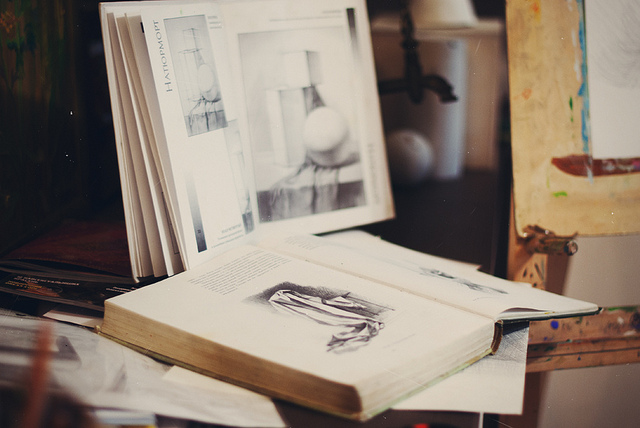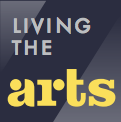
Can two artists, husband and wife, make a career and a life together in Tulare County?

We grew up together in the town of Dinuba, right in the middle of this county in the middle of California. And we didn’t think it was possible, until we tried.
If there was an arts community here when we were kids, we didn’t know about it. Dinuba was about the agriculture. Amie grew up with parents who were constantly camping in the Sierra, driving to the beach, and traveling throughout the Midwest. Matthew rode his skateboard everywhere and loved to draw. Our relationship began in a Dinuba park when Matthew threw a stick at Amie and chased her around the park. This was in 1996; Amie was in the eighth grade and Matthew a freshman in high school.
We went through many adolescent “firsts” together—driver’s licenses, concerts, jobs, accidents—and we shared our ambitions and goals. Art meant something to both of us. Matthew traces his desire to create to a drive he took in his grandfather’s Oldsmobile into the Sierra foothills, where he was captivated by views of the Kaweah Peaks and the Great Western Divide of Sequoia National Park. Amie had limited hearing as a child, heightening her sense of sight; she loved to draw outside the coloring book. She got her first sketchbook for Christmas in the sixth grade and hasn’t been without one since.
Neither of us could have imagined a life as artists when we enrolled (first Matthew, then Amie a year later) at the College of the Sequoias in nearby Visalia. But our professor Richard Peterson encouraged us, sharing artworks and introducing us to art professors around the country. Matthew still remembers browsing through oversized art books in the college library and stumbling across a monograph of Albert Bierstadt’s iconic American landscape paintings. It sparked a passion to pursue art-making with vastness and scope; he loved the idea of surveying wild places and remote regions with scientists. He also learned how to draw and paint from direct observation, which made him more visually sensitive.
But we believed that, to pursue arts as a career, we needed to look beyond the Central Valley. And, to transfer to a four-year school, we had to leave Tulare County. So we moved to California State University Long Beach. But first we got engaged. We were married a year later.
In Long Beach, we got Bachelor of Fine Arts degrees in drawing/painting and printmaking. Then we moved around North America—to the Herron School of Art and Design in Indianapolis, then to the University of Alberta in Canada, where we earned our M.F.A.s and taught for two semesters.
But we missed family, and we missed a landscape that inspired us as artists. Professor Peterson from the College of the Sequoias got in touch and reported there were two adjunct faculty who needed to be replaced. We applied, flew home on a Wednesday, were interviewed on a Thursday, and were hired Friday morning.
Matthew taught drawing and painting as well, and Amie taught drawing and a class in exhibition design. She also ran the college’s art gallery. Since the jobs were part-time, we had time to pursue our work as well. We found that we loved being home. Between teaching and making art, we made enough money to purchase our own home.
One happy discovery about Tulare County was that, during our years away, the arts had grown up. Old organizations had grown larger. New organizations (even an opera!) were getting started. All of them—Arts Visalia, Visalia Art League, Community Players, the Tulare County Symphony, Sound N Vision, Ice House Theater, Music at the Main (the list goes on)—had come together under an aggressive local umbrella organization called the Arts Consortium.
We volunteered and helped envision and coordinate events such as the Kaweah Land & Arts Festival, the Woman’s History Month Celebration, the Hatchery contemporary art exhibitions, and a tour of artists’ studios (South Valley Artists’ Studio Tour) around the county. And these events were all well-attended, in part because of partnerships between local non-profits.
Our work benefited from these community connections, in part because we both work by getting out and spending time in places that we then depict artistically. Amie recently did extensive research at commercial agricultural facilities in Tulare County, expressing those experiences with charcoal drawn on sketched linen. These compositions are often large—some are 17 feet in length and 6 feet in heights—to resemble the scale of the buildings, valves, and hoses she encountered.
Matthew’s work took the form of maps. And he eventually decide to walk a line into the mountains from El Monte Way in Dinuba, a half block from the home he grew up in, all the way into Sequoia National Park, over the Great Western Divide and up to the summit of the Black Kaweah. The walk resulted in a significant body of map-like lithographs. They examine the way human constructs of land influence our experience of place.
We were content here. But, for all our region’s resources, there is little opportunity for stable employment in higher education within the arts. Budget cuts have taken a toll at the College of the Sequoias, and we weren’t sure if there would ever be full-time jobs there. As we get older, we found ourselves becoming more interested in that stability.
Earlier this year, Matthew was offered a full-time tenure track professor of printmaking position at the University of New Mexico; because of the stability, the pay, and opportunities for continued growth in his field, we decided he should take it. Amie will continue making art and look for academic work once she gets there.
The move is bittersweet. We love this region—its history, its arts, its college, and its land, which has been our subject. We feel so fortunate to have been able to share our passion for art with students who, like us, grew up in this community.
By many standards, Tulare is still a culturally underserved county, a place that is only starting to build broad public awareness of the arts. But it is also full of opportunity, with a deeply supportive and sophisticated arts community that is connected to the world. There wasn’t a lot of ego, either. We were content there, and, with any luck—who knows?—we’ll one day find we can go home again.




Send A Letter To the Editors